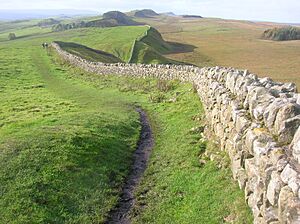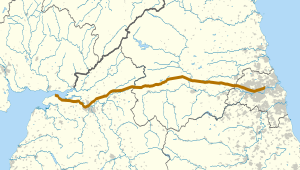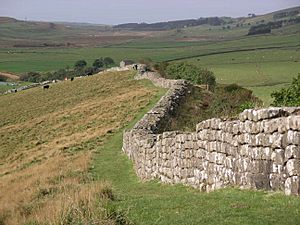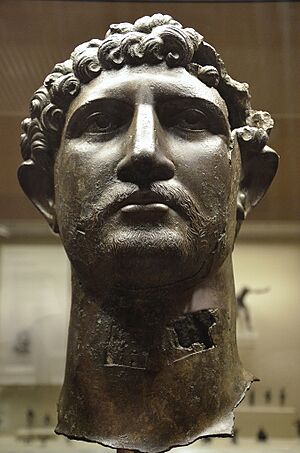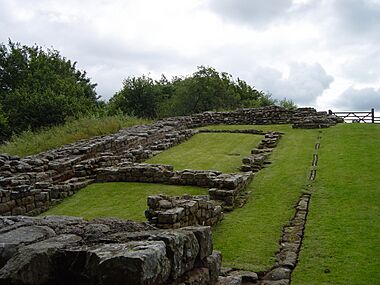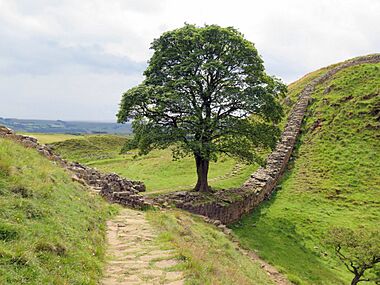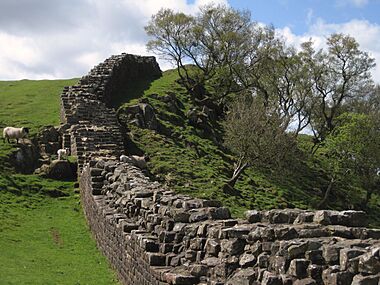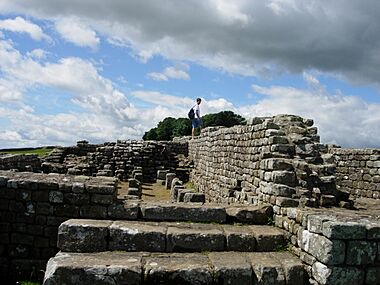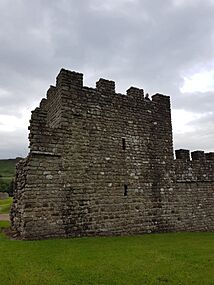Hadrian's Wall facts for kids
Quick facts for kids Hadrian's Wall |
|
|---|---|
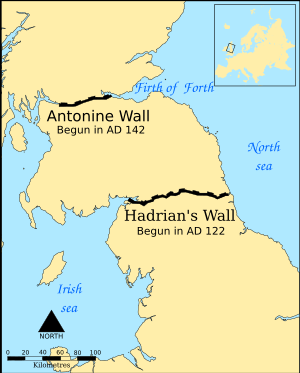
The location of Hadrian's Wall in what is now northern England, and the later Antonine Wall in what is now the Central Belt of Scotland
|
|
| Location | Northern England |
| Length | 73 miles (117 km) |
| Built | Begun 122 AD |
| Built for | Hadrian |
| Visitors | 100,000+ annually |
| Governing body | Historic England |
| Owner | Various private and public ownerships |
| Designated | 1987 (11th session) |
| Part of | Frontiers of the Roman Empire |
| Reference no. | 430 |
Hadrian's Wall is an ancient stone wall built by the Romans in what is now northern England. It was started in the year 122 AD, when Emperor Hadrian ruled. The wall stretched from Wallsend on the River Tyne in the east to Bowness-on-Solway in the west. It was a strong barrier with deep ditches on both sides.
Along the wall, Roman soldiers lived in large forts, smaller milecastles, and turrets. Besides being a defense, the wall's gates might have been places to collect customs taxes. Today, the Hadrian's Wall Path lets people walk near the wall. Most of the original stone was taken long ago to build roads and houses. None of it stands at its first height now. But, archaeologists have uncovered many parts of its base. Some sections have been rebuilt a few feet high.
Many Roman forts along the wall are open to visitors. Museums nearby share the wall's history. Hadrian's Wall is the biggest Roman ruin in Britain. It is about 73 miles (117.5 kilometres) long. It is a famous British landmark and a big tourist attraction. In 1987, it became a UNESCO World Heritage Site. The Antonine Wall, built of turf in 142 AD in Scotland, was also a World Heritage Site. It was used for a short time after Hadrian's Wall.
Hadrian's Wall marked the edge between Roman Britain and the lands to the north, called Caledonia. The wall is entirely in England. It has never been the border between England and Scotland.
Contents
How Big Was Hadrian's Wall?
The wall was 80 Roman miles long. This is about 73 miles (117 km) or 117 kilometers. It went all the way across the island, from Wallsend in the east to Bowness-on-Solway in the west.
When building started, the wall was planned to be 10 feet (3.0 m) wide. But soon, its width was made smaller, to about 8 feet (2.4 m). Some parts were first built with turf and wood. These were later replaced with stone.
Bede, a monk and historian who lived long ago (he died in 735 AD), wrote that the wall was 12 feet (3.7 metres) high. Some evidence suggests it might have been even taller when it was new. There was a watch-tower turret every third of a mile along the wall. These towers also gave shelter to Roman soldiers.
Where Did Hadrian's Wall Go?

Hadrian's Wall started at Segedunum in Wallsend on the River Tyne. It went west through Carlisle and Kirkandrews-on-Eden. It ended near the Solway Firth, a bit west of Bowness-on-Solway. The wall's path was a little north of Stanegate. This was an important Roman road built earlier. It connected two forts: Corstopitum (Corbridge) and Luguvalium (Carlisle). Today, the A69 and B6318 roads follow the wall's route.
Some parts of the wall in the middle follow natural cliffs. These cliffs are part of the Whin Sill rock formation. Even though the main wall ends near Bowness-on-Solway, the defense system continued. A line of milecastles and turrets went along the Cumbria coast. These went as far as Risehow, south of Maryport.
Why Was Hadrian's Wall Built?
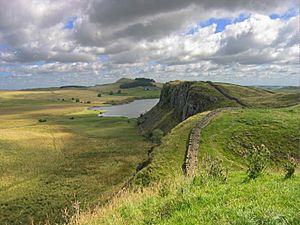
Hadrian's Wall was likely planned before Emperor Hadrian visited Britain in 122 AD. Old stone pieces found in Jarrow suggest Hadrian wanted to keep the empire "intact." He felt this was a "divine instruction." When Hadrian became emperor in 117 AD, there was unrest in Roman Britain. There were also troubles in other parts of the Empire. These problems might have made him decide to build the wall. He also built similar border walls, called limes, in other areas like Germany.
Some experts think Hadrian might have been inspired by stories of the Great Wall of China. However, others argue that the Romans had their own long history of building walls. They didn't need to look to China for ideas.
Historians still debate how much of a threat the people north of Britain really were. They also discuss if it made sense to build a fixed defense line. But Hadrian and his advisors found a solution that worked for centuries.
The main reason for the wall was to be a physical barrier. It was meant to slow down raiders. These raiders would cross to steal animals, treasure, or slaves. The wall would make it harder for them to get back with their loot. An old Latin text says:
|
(Hadrianus) murumque per octoginta milia passuum primus duxit, qui barbaros Romanosque divideret. |
(Hadrian) was the first to build a wall, eighty miles long, to separate the Romans from the barbarians. |
To make attacks even harder, there were pits called cippi in front of the wall. These pits held sharpened branches. They were like the Roman version of barbed wire. They would slow down attackers. This gave Roman defenders time to use their weapons and for more troops to arrive. The wall was not just for constant fighting. It was also a lookout point. It could warn Romans of attacks and delay enemies.
The wall also controlled who could enter and leave the Roman province. People had to use the gates in the wall. Here, they could be watched, stopped, or allowed to pass. They might also have to pay taxes.
The wall also had a big psychological impact. It showed Rome's power and skill. It marked the border between the "civilized" Roman world and the "wild" lands. The archaeologist Neil Faulkner said the wall was "as much a propaganda statement as a functional facility." There is some evidence that Hadrian's Wall was covered in white plaster. This would have made it shine in the sun and be seen from far away.
How Was Hadrian's Wall Built?
Emperor Hadrian stopped the previous emperor's plan to expand the empire. Instead, he focused on defending the existing borders. He liked using natural boundaries like rivers for borders. But Britain didn't have such natural lines to divide Roman land from the Celtic tribes in the north.
Building started in 122 AD. The wall was built with a series of forts and milecastles. Each fort held 600 men, and milecastles had 12 to 20 men.
It took six years to build most of Hadrian's Wall. Three Roman legions, with 15,000 soldiers, did the work. Some members of the Roman fleet also helped. Building was not new to these soldiers. Some were trained as surveyors, engineers, masons, and carpenters.
Broad and Narrow Sections
Archaeologists found that some parts of the wall were wider than others. The "Broad Wall" sections were about nine and a half feet (2.9 metres) wide. The "Narrow Wall" sections were about seven and a half feet (2.3 metres) wide. Some narrow sections were built on broad foundations. This suggests that plans changed during construction. The wall's width was reduced to save resources.
The original plan was for the whole wall to be stone and ten Roman feet wide. But in the end, only three-fifths of the wall was stone. The western part was built with turf, and later rebuilt in stone. The width of the eastern half was reduced to eight Roman feet. The extra stones were used for about 5 miles (8.0 kilometres) of the turf wall in the west. This change created the "Narrow Wall."
The Vallum Ditch
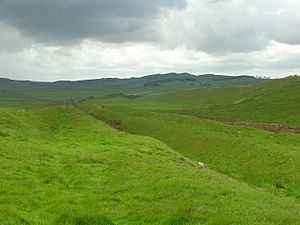
Just south of Hadrian's Wall, there is a ten-foot (three-metre) deep ditch. It has two parallel mounds running north and south of it. This is called the Vallum. The Vallum runs mostly parallel to the wall for almost its entire length. It is not present at the very east end, near Newcastle and Wallsend. Here, the River Tyne was already a good barrier.
Some evidence suggests the wall's path was changed to avoid the Vallum. This made some think the Vallum was built first. However, later research showed the Vallum avoided one of the wall's milecastles. This means they were likely built at the same time. Other findings suggest the Vallum was built faster than the Narrow Wall sections.
Turf Wall Sections
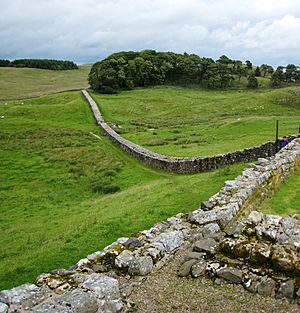
From Milecastle 49 to the western end at Bowness-on-Solway, the wall was first made of turf. This was probably because there wasn't enough limestone for mortar in that area. Later, this turf wall was taken down and replaced with a stone wall. This happened in two stages. The first was during Hadrian's rule. The second was after the Romans came back to Hadrian's Wall, after leaving the Antonine Wall.
The new stone wall followed the path of the turf wall. But between Milecastle 49 and Milecastle 51, the stone wall was a little further north. The turf wall was about 6 metres (20 feet) wide at its base. It was built with turf blocks. These blocks were about 46 cm (18 inches) long, 30 cm (12 inches) deep, and 15 cm (6 inches) high. The wall was estimated to be about 3.66 metres (12.0 feet) tall.
Who Guarded Hadrian's Wall?
After the wall was built, nearly 10,000 soldiers were stationed there. These soldiers were not the legions who built the wall. Instead, they were auxiliary infantry and cavalry units from other Roman provinces.
David Breeze explained that soldiers had two main jobs. Those in the forts defended the area. Those in the milecastles and turrets controlled the border. There is more evidence for soldiers in forts than in milecastles and turrets.
Breeze suggested three ideas about the soldiers in milecastles and turrets:
- They came from nearby forts.
- Specific auxiliary units were chosen for this job.
- A "special force" was created to man these stations.
Breeze found that inscriptions show soldiers from three or four auxiliary units were at milecastles. There were also some legionaries. Breeze believes it's more likely that soldiers were specially chosen for these tasks.
The Vindolanda tablets, found south of the wall, give more information. For example, one record from 92 or 97 AD shows that only 456 out of 756 Belgae troops were present. The rest were sick or absent.
Life Around Hadrian's Wall
Cultural Changes
Long before the Romans, the area around the wall had many farms and settlements. The wall likely cut through a region that shared a similar culture. It was built during a time of serious fighting in Britain. This required many Roman soldiers to come from other parts of the empire.
Roman soldiers and their families made up a large part of the population near the wall. They might have been 22-30% of the people. They couldn't get all their food and supplies locally. Any extra local food would have been taxed or taken by the Romans.
South of the Wall
South of the wall, Roman-style settlements appeared soon after the wall was built. This was earlier than in other parts of Britain. Roman pottery was made south of the wall and found at forts like Coria. This shows that Roman culture quickly spread among local leaders and new settlers.
North of the Wall
North of the wall, things were very different. A large area of what is now southern Scotland lost its traditional building styles. Very little Roman pottery has been found there. The Romans might have moved people out of this area. Some sites were still used, possibly to manage livestock for the Romans. Pollen evidence suggests the land north of the wall stayed open, without forests, until the end of Roman rule.
Limited Contact Across the Wall
Generally, Roman coins and pottery did not cross the wall. The wall seemed to stop trade. A few important places still imported Roman goods. Trade might have happened at specific crossing points or times of year. For example, many Roman metal objects were found near Great Whittington. This was about 2 kilometers north of the Portgate on the wall. These finds suggest trade happened there.
What Happened After Hadrian?

After Hadrian died in 138 AD, the new emperor, Antoninus Pius, left Hadrian's Wall mostly empty. He started building the Antonine Wall about 160 kilometres (100 mi) north. This turf wall was about 60.8 km (37.8 mi) long and had more forts. This area is now known as the Scottish Lowlands.
Antoninus couldn't fully conquer the northern tribes. So, when Marcus Aurelius became emperor, he left the Antonine Wall. In 164 AD, he made Hadrian's Wall the main defense again. Later, in 208–211 AD, Emperor Septimius Severus tried to conquer Caledonia again. He briefly used the Antonine Wall. But his campaign failed, and the Romans returned to Hadrian's Wall.
The early historian Bede (who lived from 672/73 to 735 AD) wrote that the Romans built a strong stone wall from sea to sea. He thought this was to help the Britons they were leaving behind. Bede lived near the wall and knew it well. He described it as "eight feet in breadth, and twelve in height." He said it ran straight from east to west.
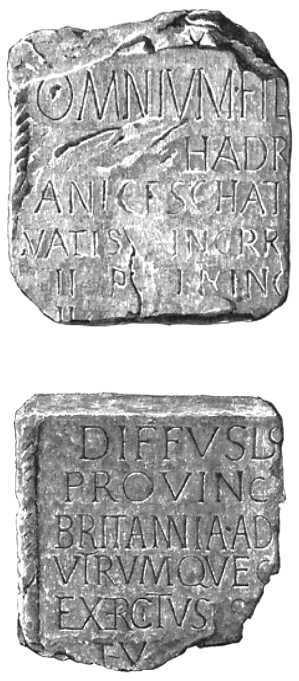
By the late 4th century, the Roman Empire's control over Britain weakened. By 410 AD, the Roman army left Britain. The wall fell into ruin over centuries. Its stones were reused for other local buildings. Even in the 7th century, stones from Hadrian's Wall were used to build St Paul's Church in Monkwearmouth-Jarrow Abbey, where Bede was a monk.
Preservation Efforts
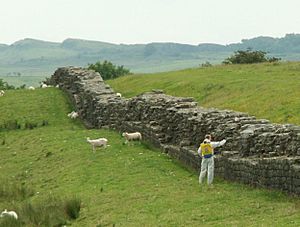
Much of the wall has disappeared. Long sections were used to build roads in the 18th century. For example, General Wade used stones to build a military road. This road helped move troops to stop the Jacobite rising of 1745.
The preservation of what remains is largely thanks to John Clayton. He was a lawyer and became town clerk of Newcastle in the 1830s. He loved the wall after visiting Chesters. To stop farmers from taking stones, he started buying land where the wall stood. He bought land from Brunton to Cawfields. This included famous sites like Chesters, Carrawburgh, Housesteads, and Vindolanda. Clayton also dug up parts of the forts and milecastles.
Clayton used money from his farms to restore parts of the wall. Workers rebuilt sections up to about seven stone layers high. The best example of Clayton's work is at Housesteads. After Clayton died, his land eventually went to the National Trust. At Wallington Hall, there is a painting by William Bell Scott. It shows a Roman centurion supervising the wall's building. The centurion's face is actually John Clayton's.
Recent Discoveries
In 2021, workers found a new 3-meter section of the wall in central Newcastle upon Tyne. They were fixing a water pipe. The company said they would change the pipe's angle to protect the wall.
World Heritage Site and Tourism
Hadrian's Wall became a World Heritage Site in 1987. In 2005, it joined the "Frontiers of the Roman Empire" World Heritage Site. This also includes Roman sites in Germany.
Visitors can climb and stand on the wall, but this is not encouraged. It can damage the old structure. In March 2010, 500 beacons lit up the wall's route for an event called Illuminating Hadrian's Wall. In 2012, there was another light show called "Connecting Light." In 2018, the groups managing the Great Wall of China and Hadrian's Wall agreed to work together. They want to boost tourism and understanding of both monuments.
Hadrian's Wall Path
In 2003, a National Trail footpath opened. It follows the wall from Wallsend to Bowness-on-Solway. To protect the fragile landscape, walkers are asked to use the path only in summer.
Roman Names for the Wall and Forts
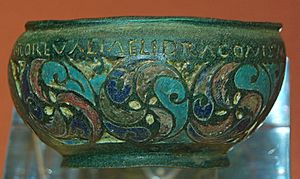
In Roman times, Hadrian's Wall was called the vallum (wall). A discovery in 2003, the Staffordshire Moorlands Pan, gave more clues about its name. This old copper pan has the names of four Roman forts along the western wall. It also has the words RIGORE VALI AELI DRACONIS. Hadrian's family name was Aelius. So, Valli Aelii likely means "Hadrian's Wall." This suggests people at the time called it by his name.
Two other similar bronze pans, the Rudge Cup and the Amiens Skillet, also show names of Hadrian's Wall forts. They also have pictures of a wall with towers, likely showing Hadrian's Wall.
Forts Along the Wall
The Roman and modern English names of all Hadrian's Wall forts are known. Here they are, from east to west:
- Segedunum (Wallsend)
- Pons Aelius (Newcastle upon Tyne)
- Condercum (Benwell Hill)
- Vindobala (Rudchester)
- Hunnum (Halton Chesters)
- Cilurnum (Chesters aka Walwick Chesters)
- Procolita (Carrawburgh)
- Vercovicium (Housesteads)
- Aesica (Great Chesters)
- Magnis (Carvoran)
- Banna (Birdoswald)
- Camboglanna (Castlesteads)
- Uxelodunum (Stanwix. Also known as Petriana)
- Aballava (Burgh-by-Sands)
- Coggabata (Drumburgh)
- Mais (Bowness-on-Solway)
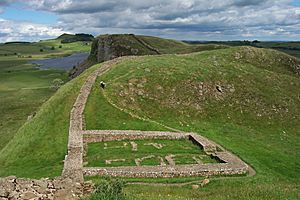
Some turrets on the wall include:
Outpost forts beyond the wall include:
- Habitancum (Risingham)
- Bremenium (High Rochester)
- Fanum Cocidi (Bewcastle) (north of Birdoswald)
- Ad Fines (Chew Green)
Supply forts behind the wall include:
- Alauna (Maryport)
- Arbeia (South Shields)
- Coria (Corbridge)
- Epiacum (Whitley Castle near Alston)
- Vindolanda (Little Chesters or Chesterholm)
- Vindomora (Ebchester)
Hadrian's Wall in Books, Movies, and Games
Books
- The Eagle of the Ninth (1954) by Rosemary Sutcliff is a famous children's novel. It's about a young Roman officer who goes north of Hadrian's Wall to find a lost Roman eagle standard. This book inspired the 2011 movie The Eagle.
- Rudyard Kipling wrote short stories about a Roman soldier named Parnesius who defended the wall against the Picts. These stories are in his book Puck of Pook's Hill (1906).
- Author George R. R. Martin said Hadrian's Wall inspired "the Wall" in his A Song of Ice and Fire book series. This series was made into the TV show Game of Thrones.
- Hadrian's Wall by Adrian Goldsworthy is a short history book about the wall.
Films
- The 1991 movie Robin Hood: Prince of Thieves used Sycamore Gap near the wall as a filming location.
- The 2011 film The Eagle and the 2010 film Centurion both tell stories about Roman soldiers going beyond Hadrian's Wall.
- The 2004 movie King Arthur features Hadrian's Wall. A main gate is opened for the first time to let Arthur and his knights go north. The big battle in the movie happens just inside the wall.
Music
- The first song on Maxim's solo album Hell's Kitchen is called "Hadrian's Wall."
Television
- An episode of the TV show Modern Marvels was about Hadrian's Wall. It aired on March 1, 2001.
Poetry
- The poet W. H. Auden wrote a radio show script called Hadrian's Wall in 1937. He later published a poem from it, "Roman Wall Blues." It's from the point of view of a lonely Roman soldier at the wall.
Video Games
- Hadrian's Wall appears in Assassin's Creed Valhalla. Players can visit the site in the game.
- Hadrian's Wall is a historical building in Crusader Kings III. It gives economic benefits to players who control it.
Board Games
- A board game called Hadrian's Wall was released in 2021. In the game, players build and defend the wall. It was nominated for an award in 2022.
Gallery
-
Poltross Burn, Milecastle 48, which was built on a steep slope
-
The Sycamore Gap tree, which was felled in 2023 in an act of vandalism (also known as the "Robin Hood Tree", because it appeared in the film Robin Hood: Prince of Thieves)
-
The remains of the southern granary at Housesteads, showing under-floor pillars to assist ventilation
-
A modern reconstruction of a short segment of Hadrian's Wall at Vindolanda
See also
 In Spanish: Muro de Adriano para niños
In Spanish: Muro de Adriano para niños


